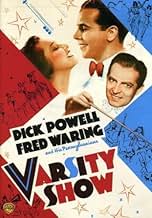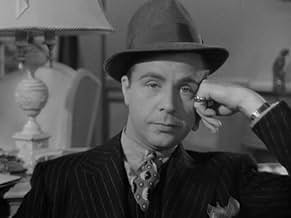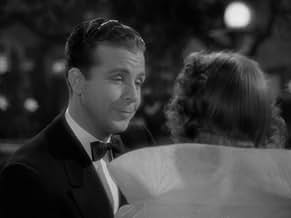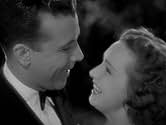A former student who is now a big Broadway show producer with three flops to his reputation, is invited back to direct the College's annual student stage show.A former student who is now a big Broadway show producer with three flops to his reputation, is invited back to direct the College's annual student stage show.A former student who is now a big Broadway show producer with three flops to his reputation, is invited back to direct the College's annual student stage show.
- Nominated for 1 Oscar
- 1 win & 1 nomination total
Johnnie Davis
- Buzz Bolton
- (as Johnny Davis)
Ford Washington Lee
- Buck
- (as Buck)
John W. Bubbles
- Bubbles
- (as Bubbles)
Featured reviews
This is not "Gold diggers of 1933" or "Footlight Parade," but it is a competent and fun musical. While not an "A" picture, it is a solid "B." There may not be anything great here, but everything is loud, energetic and good. There are many small delights for people willing to look
This was directed by William Keighley between two excellent Errol Flynn movies that he directed: "The Prince and the Pauper" and "Adventures of Robin Hood". He also did directed two fine James Cagney movies, "G Men" and "Each Dawn I Die". He also did the classic comedy, "The Man Who Came to Dinner" The movie has a bunch of fine second bananas, Walter Catlett, Sterling Holloway and Ted Healey. Catlett had bit parts in many classic comedies, for example, "Bringing up Baby" and "Mr. Deeds Goes to Town" He was a much in demand actor doing 50 films between 1940 and 1944, getting 6th-10th billing in almost all of them. Adorable Sterling Holloway adds his nice spaecy bits. Even Ted Healey, who is associated with the Three Stooges comes off well. He played the leader of the Three Stooges, a part that the Moe Fine took over when they split up. In the movie, he is referred to as a stooge and he plays the part convincingly.
This is the first movie for Priscilla and Rosemary Lane. There older sister, Lola, had been a star for eight years by this. All three sisters would continue to make movies for about ten more years. While I'm unfamiliar with Rosemary Lane's films, Priscilla was in at least three classics, "Arsenic and Old Lace" "The Roaring Twenties" and Alfred Hitchcock's "Saboteur. Both sisters are delightful here.
George Washington Lee and William Sublett as Buck and Bubbles do a couple of wonderful dance routines.
The finale is by Busby Berkeley. While people are right to point out that this football number is not one of his best, even average Busby Berkeley is better than most musical numbers by anybody else.
Overall, the movie doesn't dazzle, but it zips along, brightens the day and puts a smile on your face. I would love to see the missing 40 minutes.
This was directed by William Keighley between two excellent Errol Flynn movies that he directed: "The Prince and the Pauper" and "Adventures of Robin Hood". He also did directed two fine James Cagney movies, "G Men" and "Each Dawn I Die". He also did the classic comedy, "The Man Who Came to Dinner" The movie has a bunch of fine second bananas, Walter Catlett, Sterling Holloway and Ted Healey. Catlett had bit parts in many classic comedies, for example, "Bringing up Baby" and "Mr. Deeds Goes to Town" He was a much in demand actor doing 50 films between 1940 and 1944, getting 6th-10th billing in almost all of them. Adorable Sterling Holloway adds his nice spaecy bits. Even Ted Healey, who is associated with the Three Stooges comes off well. He played the leader of the Three Stooges, a part that the Moe Fine took over when they split up. In the movie, he is referred to as a stooge and he plays the part convincingly.
This is the first movie for Priscilla and Rosemary Lane. There older sister, Lola, had been a star for eight years by this. All three sisters would continue to make movies for about ten more years. While I'm unfamiliar with Rosemary Lane's films, Priscilla was in at least three classics, "Arsenic and Old Lace" "The Roaring Twenties" and Alfred Hitchcock's "Saboteur. Both sisters are delightful here.
George Washington Lee and William Sublett as Buck and Bubbles do a couple of wonderful dance routines.
The finale is by Busby Berkeley. While people are right to point out that this football number is not one of his best, even average Busby Berkeley is better than most musical numbers by anybody else.
Overall, the movie doesn't dazzle, but it zips along, brightens the day and puts a smile on your face. I would love to see the missing 40 minutes.
No need to repeat details exhaustively provided by other reviewers. I caught the 80-minute truncated version on TCM and it's a shame despite the lively cast and Berkeley's big production number. Comparing the playlist with what's on screen, most of the musical numbers that survived the edit appear condensed into the closing medley of songs—hardly a fair representation. And what's left intact is musically pleasant but hardly memorable. Generally, the same can be said of the truncated movie as a whole.
(In passing—note the rebellious college students impatient with the stodgy musical tastes of their elders. Seems like musical rebellion among the young extends further back than the 1950's and Elvis. More obscurely-- note how the kids at one juncture perform a brief sit-down strike to make their point. The year is 1937, the same period as the historic General Motors Sitdown Strike of 1936-37. Looks to me like a topical reference even in a movie piece of fluff.)
(In passing—note the rebellious college students impatient with the stodgy musical tastes of their elders. Seems like musical rebellion among the young extends further back than the 1950's and Elvis. More obscurely-- note how the kids at one juncture perform a brief sit-down strike to make their point. The year is 1937, the same period as the historic General Motors Sitdown Strike of 1936-37. Looks to me like a topical reference even in a movie piece of fluff.)
VARSITY SHOW (Warner Brothers, 1937), directed by William Keighley, is a college campus musical, in fact, Warners' only contribution to the college musical of the 1930s. Originally distributed in theaters at two hours in length, circulating prints are from the 1940s reissue at 79 minutes, with 40 minutes of material clipped from the original negative and lost since then. Considering this edition happened to be the only known print in existence today, this review is taken on the basis from the edited version.
The story begins with Ernie Mason (Fred Waring) and his fellow students of Winfield College rehearsing for the upcoming annual varsity show. Ernie, assistant to Professor Sylvester Biddle (Walter Catlett), the faculty adviser, finds he and the students aren't being given the freedom they need to put on a successful show. Biddle insists the show be done his way or none at all, in spite that his ideas are out-of-date and his refusal to allow swing music as part of the score. Janitors Buck and Bubbles come up with an idea in hiring Charles "Chuck" Daly (Dick Powell), a former alumnus now a successful Broadway producer, to help direct the show. Betty Bradley (Priscilla Lane), Buzz Bolton (Johnnie Davis), Johnny "Rubberlegs" Stevens (Lee Dixon) and Trout (Sterling Holloway) volunteer in coming to New York City to locate Daly. At first Daly refuses, but because Daly has just closed his latest Broadway flop (his third in a row), he and his assistant, William W. Williams (Ted Healy) decide to return to Winfield College where they not only agree to help direct the varsity show, but become part of the fraternity by staying in the dormitory run by Mrs. Smith (Emma Dunn), as well as finding themselves suitable love partners, Daly with Barbara Steward (Rosemary Lane) and gravel voice Williams with Cuddles (Mabel Todd), a buck-tooth, bespectacled blonde with a very peculiar laugh.
With the music and lyrics by Johnny Mercer and Richard Whiting, the good selection of songs from the 79 minute print includes: "The Varsity Show's Rehearsing Today at Three O'Clock" (sung by cast); "Old King Cole" (sung by Johnnie Davis); "We're Working Our Way Through College" (sung by Dick Powell); "I'm Dependable" (sung by Priscilla Lane and Fred Waring/ written by Tom Waring and Don Raye); "On With the Dance" (sung by Rosemary Lane); "You Got Something There" (sung by Dick Powell and Rosemary Lane); Tap dance solo act performed by Buck and Bubbles; "Have You Got Any Castles, Baby?" (sung by Priscilla Lane); "Love Is on the Air Tonight" (sung by Buck and Bubbles); "Have You Got Any Castles, Baby?" (tap dance by Buck and Bubbles); "On With the Dance" (sung by Buck and Bubbles); "Old King Cole" (sung by Johnnie Davis); "On With the Dance" (reprise); "You Got Something There" and "Love Is On the Air Tonight." If one looks very closely to the opening credits and to the list of songs, one tune, "Little Fraternity Pin," is listed but not heard in VARSITY SHOW.
As much the story may be as predictable as any college musical of that time, the majority of the songs for this production were quite standard. Forgotten today, VARSITY SHOW contains the most entertaining college finale ever presented. Choreographed by Busby Berkeley, it did get nominated for an Academy Award in the best dance direction category. Though it didn't win, VARSITY SHOW still demonstrates Berkeley's true ability in his creative staging techniques. With Fred Waring and his Pennsylvanians orchestrating the finale, the real show stopper centers upon an individual co-ed throwing a football on numerous occasions across the stage over to a group of students to form themselves into spelled-out letters of well known universities as Yale, Wisconsin, Notre Dame and Stanford. All these letters are used with color tiles with the underscoring to just about every familiar college song imaginable. It's an excellent production that makes up for whatever flaws the film itself contains. Buck and Bubbles shouldn't go unnoticed. They, too, contribute to several good dance routines. Not quite as effective and faster style of the Nicholas Brothers over at 20th Century-Fox, but a routinely style all their own.
The supporting cast includes: Halliwell Hobbes (Dean J. M. Meredith); Edward Brophy (Mike "Curly" Barclay); Ben Weldon, Robert Homans and Tom Kennedy. Lee Dixon, who was becoming a familiar secondary character in the Warners musicals as GOLD DIGGERS OF 1937 (1936), READY, WILLING AND ABLE (1937), and THE SINGING MARINE (1937), makes his final bow in VARSITY SHOW. In the edited version, he not only limited in his contribution to the story (though possibly had extensive scenes from the two hour edition), but had his name placed thirteenth in the closing cast credits. He later scored successfully in the Broadway musical, OKLAHOMA (1943), and appeared one more time on screen in the western drama, ANGEL AND THE BAD MAN (Republic, 1946), starring John Wayne, before his death in 1953.
VARSITY SHOW in present form is a pleasing musical with a bright score. (One can hope the missing footage will someday suffice and take the place of the chopped-up copy on TCM). As for the cast, Dick Powell, Ted Healy, Rosemary Lane, Johnnie Davis and Mabel Todd appeared together again in another large scale Warners musical, "Hollywood Hotel" (1937), that introduced the popular theme song, "Hooray for Hollywood." Directed entirely by Busby Berkeley, it lacked the great musical finish that highlights VARSITY SHOW so well. Rah! Rah! Rah! (***1/2)
The story begins with Ernie Mason (Fred Waring) and his fellow students of Winfield College rehearsing for the upcoming annual varsity show. Ernie, assistant to Professor Sylvester Biddle (Walter Catlett), the faculty adviser, finds he and the students aren't being given the freedom they need to put on a successful show. Biddle insists the show be done his way or none at all, in spite that his ideas are out-of-date and his refusal to allow swing music as part of the score. Janitors Buck and Bubbles come up with an idea in hiring Charles "Chuck" Daly (Dick Powell), a former alumnus now a successful Broadway producer, to help direct the show. Betty Bradley (Priscilla Lane), Buzz Bolton (Johnnie Davis), Johnny "Rubberlegs" Stevens (Lee Dixon) and Trout (Sterling Holloway) volunteer in coming to New York City to locate Daly. At first Daly refuses, but because Daly has just closed his latest Broadway flop (his third in a row), he and his assistant, William W. Williams (Ted Healy) decide to return to Winfield College where they not only agree to help direct the varsity show, but become part of the fraternity by staying in the dormitory run by Mrs. Smith (Emma Dunn), as well as finding themselves suitable love partners, Daly with Barbara Steward (Rosemary Lane) and gravel voice Williams with Cuddles (Mabel Todd), a buck-tooth, bespectacled blonde with a very peculiar laugh.
With the music and lyrics by Johnny Mercer and Richard Whiting, the good selection of songs from the 79 minute print includes: "The Varsity Show's Rehearsing Today at Three O'Clock" (sung by cast); "Old King Cole" (sung by Johnnie Davis); "We're Working Our Way Through College" (sung by Dick Powell); "I'm Dependable" (sung by Priscilla Lane and Fred Waring/ written by Tom Waring and Don Raye); "On With the Dance" (sung by Rosemary Lane); "You Got Something There" (sung by Dick Powell and Rosemary Lane); Tap dance solo act performed by Buck and Bubbles; "Have You Got Any Castles, Baby?" (sung by Priscilla Lane); "Love Is on the Air Tonight" (sung by Buck and Bubbles); "Have You Got Any Castles, Baby?" (tap dance by Buck and Bubbles); "On With the Dance" (sung by Buck and Bubbles); "Old King Cole" (sung by Johnnie Davis); "On With the Dance" (reprise); "You Got Something There" and "Love Is On the Air Tonight." If one looks very closely to the opening credits and to the list of songs, one tune, "Little Fraternity Pin," is listed but not heard in VARSITY SHOW.
As much the story may be as predictable as any college musical of that time, the majority of the songs for this production were quite standard. Forgotten today, VARSITY SHOW contains the most entertaining college finale ever presented. Choreographed by Busby Berkeley, it did get nominated for an Academy Award in the best dance direction category. Though it didn't win, VARSITY SHOW still demonstrates Berkeley's true ability in his creative staging techniques. With Fred Waring and his Pennsylvanians orchestrating the finale, the real show stopper centers upon an individual co-ed throwing a football on numerous occasions across the stage over to a group of students to form themselves into spelled-out letters of well known universities as Yale, Wisconsin, Notre Dame and Stanford. All these letters are used with color tiles with the underscoring to just about every familiar college song imaginable. It's an excellent production that makes up for whatever flaws the film itself contains. Buck and Bubbles shouldn't go unnoticed. They, too, contribute to several good dance routines. Not quite as effective and faster style of the Nicholas Brothers over at 20th Century-Fox, but a routinely style all their own.
The supporting cast includes: Halliwell Hobbes (Dean J. M. Meredith); Edward Brophy (Mike "Curly" Barclay); Ben Weldon, Robert Homans and Tom Kennedy. Lee Dixon, who was becoming a familiar secondary character in the Warners musicals as GOLD DIGGERS OF 1937 (1936), READY, WILLING AND ABLE (1937), and THE SINGING MARINE (1937), makes his final bow in VARSITY SHOW. In the edited version, he not only limited in his contribution to the story (though possibly had extensive scenes from the two hour edition), but had his name placed thirteenth in the closing cast credits. He later scored successfully in the Broadway musical, OKLAHOMA (1943), and appeared one more time on screen in the western drama, ANGEL AND THE BAD MAN (Republic, 1946), starring John Wayne, before his death in 1953.
VARSITY SHOW in present form is a pleasing musical with a bright score. (One can hope the missing footage will someday suffice and take the place of the chopped-up copy on TCM). As for the cast, Dick Powell, Ted Healy, Rosemary Lane, Johnnie Davis and Mabel Todd appeared together again in another large scale Warners musical, "Hollywood Hotel" (1937), that introduced the popular theme song, "Hooray for Hollywood." Directed entirely by Busby Berkeley, it lacked the great musical finish that highlights VARSITY SHOW so well. Rah! Rah! Rah! (***1/2)
I wonder what happened with the missing 40 minutes from "Varsity Show". IMDb lists its original running time as 120 minutes but the Turner DVD is only 80--meaning a third of the film is missing. Perhaps this is just a mistake and the film was always 80 minutes but I wonder if the studio thought 120 minutes made the film incredibly sluggish and they decided to re-edit it--though cutting out THAT much seems very unlikely. Can anyone shed any light on this for me?
Dick Powell as well as Fred Waring and his orchestra star in this light-hearted college musical. Apparently the folks at Winfield College are going to put on another VERY boring show--thanks to the very dull Professor Biddle who insists they do it his way. The students want to breath energy into the program and invite Mr. Daly (Powell) to 'spice it up'. But the faculty is adamant--so what are these co-eds to do? Why SING of course! And, in the end, instead of Mr. Daly saving the college show, the students (much like in "Babes on Broadway") put on a show to save the career of swell 'ol Mr. Daly.
Overall, this is pure escapist fun. While the songs aren't particularly memorable, they are enjoyable. And the final BIG production number (choreographed by Busby Berkeley) is also quite amazing--and better than most of his efforts. While I am not a huge fan of this sort of film, for what this is, it's amazingly well done. Proof that it wasn't just MGM that could make a nice musical, as Warner had a long string of big production number musicals in the 30s. Worth seeing.
By the way, I liked Dick Powell's line "Get back to your rooms and crack a book...". That's because in practically every college film of the 30s and 40s, you almost NEVER see these folks studying or attending classes! Seeing them in the next scene actually studying was a shocker! Although, not surprisingly, the studying session didn't last very long!
Dick Powell as well as Fred Waring and his orchestra star in this light-hearted college musical. Apparently the folks at Winfield College are going to put on another VERY boring show--thanks to the very dull Professor Biddle who insists they do it his way. The students want to breath energy into the program and invite Mr. Daly (Powell) to 'spice it up'. But the faculty is adamant--so what are these co-eds to do? Why SING of course! And, in the end, instead of Mr. Daly saving the college show, the students (much like in "Babes on Broadway") put on a show to save the career of swell 'ol Mr. Daly.
Overall, this is pure escapist fun. While the songs aren't particularly memorable, they are enjoyable. And the final BIG production number (choreographed by Busby Berkeley) is also quite amazing--and better than most of his efforts. While I am not a huge fan of this sort of film, for what this is, it's amazingly well done. Proof that it wasn't just MGM that could make a nice musical, as Warner had a long string of big production number musicals in the 30s. Worth seeing.
By the way, I liked Dick Powell's line "Get back to your rooms and crack a book...". That's because in practically every college film of the 30s and 40s, you almost NEVER see these folks studying or attending classes! Seeing them in the next scene actually studying was a shocker! Although, not surprisingly, the studying session didn't last very long!
For die-hard Berkeley fans only--this collegiate musical is certainly more a mirror of it's time than most, with lots of college men over 30 clad in beanies swooning in song over long-skirted coeds; simple plot--all the students want to present the hot new rhythms of the New Varsity Show, but the fuddy-duddy professor (Walter Catlett in usual sputtering mode) won't let them. Enter former alum and Broadway Star Dick Powell, all dimples and smiles, intent on Saving The Day With Music! The whole enterprise is a build up to the sensational Busby Berkeley finale with hundreds of dancing coeds in astounding geometrical designs; unfortunately, the less-than-memorable music is not by Al Dubin and Harry Warren (who composed the Gold Diggers series).
According to Tony Thomas's Busby Berkeley book, and reliable film historian Leslie Halliwell (and numerous other sources), this should be a 120 minute film; why has Turner, usually the standard for accuracy, released an 80 minute print--40 minutes shorter? Some collector, somewhere, must be sitting on an old studio print and, if anybody is able, the intrepid folks at Turner will track it down and we can see what will probably make this the dynamic vintage musical it should be.
According to Tony Thomas's Busby Berkeley book, and reliable film historian Leslie Halliwell (and numerous other sources), this should be a 120 minute film; why has Turner, usually the standard for accuracy, released an 80 minute print--40 minutes shorter? Some collector, somewhere, must be sitting on an old studio print and, if anybody is able, the intrepid folks at Turner will track it down and we can see what will probably make this the dynamic vintage musical it should be.
Did you know
- TriviaWhen Fred Waring was approached to play a starring role in this film, he brought his famous glee club, The Pennsylvanians, to the shoot and planned on using the college glee club from Pomona College for additional singers. When he arrived at the campus he found the Glee Club conductor was ill but his replacement was a young, energetic man named Robert Shaw. After the movie was finished, Shaw followed Waring to New York, where he founded the Collegiate Chorale and the Robert Shaw Chorale. Robert Shaw went on to be one of the most important personalities in American choral music in the 20th century.
- Quotes
Professor Sylvester Biddle: [to Chuck and Williams] Oh, uh, I'm very glad that I ran into you.
William Williams: Well, I'm glad I run into you. It's too bad it wasn't in my truck.
- ConnectionsFeatured in No Maps on My Taps (1979)
- SoundtracksOld King Cole
(1937) (uncredited)
Music by Richard A. Whiting
Lyrics by Johnny Mercer
Played by Fred Waring and His Pennsylvanians and sung by Johnnie Davis
Reprised with Priscilla Lane and Lee Dixon dancing
Reprised in the finale with Johnnie Davis singing
Details
- Runtime
- 2h(120 min)
- Color
- Sound mix
- Aspect ratio
- 1.37 : 1
Contribute to this page
Suggest an edit or add missing content


































